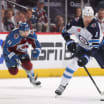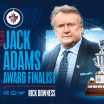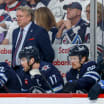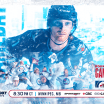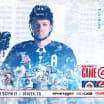When the product of West Seneca, NY broke into the NHL with the St. Louis Blues in 2005, it was the culmination of a long road filled with hard work.
"I was drafted when I was 20-years-old, I played four years of college. It wasn't a quick path for me," he said. "I loved learning about the game and trying to get better, and adding new skills so you can play for more ice time and opportunity."
That work ethic caught the eye of Blues veterans, and former Jets, Keith Tkachuk and Dallas Drake.
Tkachuk played 308 games for the Jets between 1991 and 1996, recording his first 50-goal season in the team's final year in Winnipeg. Drake played parts of three seasons with the Jets between 1993 and 1996, and was the Blues captain when Stempniak arrived.
"They were just really great to me," said Stempniak. "They taught me a lot off the ice, they taught me a lot on the ice in how they prepared, what they did, and little tricks and things before and after practice. It was something I tried to carry on as I became a more veteran player."
That's exactly what he did. Over the course of his 911 NHL games, Stempniak played for 10 teams - St. Louis, Toronto, Phoenix, Calgary, Pittsburgh, New York Rangers, Winnipeg, New Jersey, Carolina, and Boston - and no matter where he was in his career, he always had time to help.
Even when he wasn't playing much, like during his final NHL season in 2018-19. He was on a professional tryout with the Bruins up until the trade deadline, at which time he signed a contract and played primarily for their American Hockey League affiliate in Providence.
"I got to skate a lot with the injured players after practice and I really enjoyed it. I skated with Charlie McAvoy for a month when he was hurt," Stempniak said. "We were in the gym together and skating together. It just reinforced that it was something I really enjoyed and felt like all the different experiences I had as a player would really help."
Stempniak finished his NHL career with 203 goals and 469 points and when he says he's had different experiences, he means it. He's played on a line with Sidney Crosby, been a healthy scratch, and everything in between.
He's had numerous coaches, watched how different personalities in the room interacted with each other, and spent his one year away from the NHL in 2019-20 volunteering as an assistant coach to develop his own ability to relate to young players.
"I actually volunteered at a local high school and coached with Freddy Meyer, an old Atlanta Thrasher pre-Winnipeg Jets," said Stempniak. "I sort of studied a lot of different things, thought about what I wanted to do, how I'd relate to different players, different types of people, how people learn, and what I'd prioritize."
He returned to the NHL as a Data Analyst for the Coyotes in 2020-21 and spent two years in that position before officially accepting the Player Development role on August 29.
Now he's ready to take all he's learned, and apply it to the next generation of NHL players.
"I've gone through most of the experiences these guys will go through," he said. "Those experiences, the different people I was exposed to, I just saw a ton of different personalities. How different coaches treated players. To me, the good coaches, all did things a bit differently but could interact with players and meet them where they were. Whether that was how to motivate them - a pat on the back or a kick in the butt - no two people are the same and they respond differently.
"Those are things that stood out to me and hopefully I can implement."







